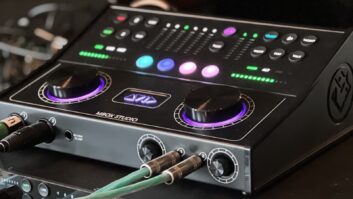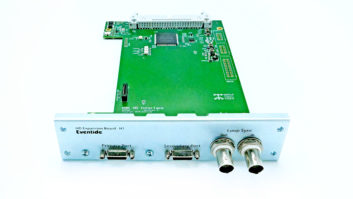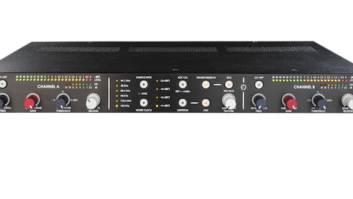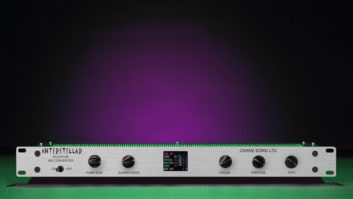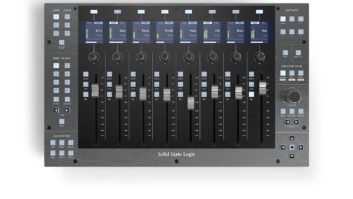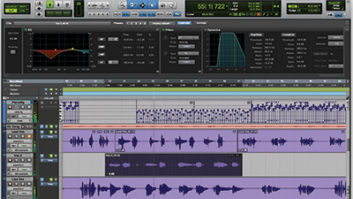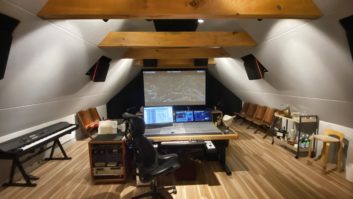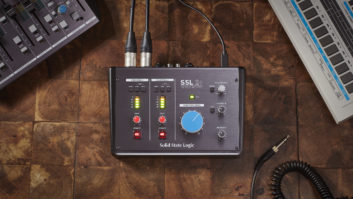Generation HDX provides Pro Tools users with Avid’s most powerful and fastest DAW to date.
Pro Tools HD has spent a decade at the pinnacle of the recording industry where it has been the staple system against which every DAW is measured. After a long, glorious life, the platform has finally matured into an aging system in need of retirement. Avid released the amazing HD Native system two years ago and, while this platform is adequate for most users (its 32-bit floating point processing provides higher quality audio processing than HD Accel), it lacks the power and speed required by some high-end Pro Tools users. For them, there’s HDX.
Pro Tools HDX was officially launched at last October’s AES show and it represents a major step forward as well as a major change to the Pro Tools platform. It’s interesting to note that Pro Tools|Mix had only been in the marketplace for four years before HD was released, but HD has had a decade-long life without being updated. So yes, it’s time to move into the next generation of Pro Tools performance.
Features
A single Pro Tools HDX card provides up to 5x more power than a Pro Tools|HD Accel card. It supports 4x more tracks (up to 768 voices) double the ins and outs with up to 64 channels of I/O per card (up to 256 total) and 4x longer Automatic Delay Compensation. Pro Tools HDX utilizes floating-point calculations for plug-in processing and mixing, resulting in more headroom and a level of sound quality previously not possible with Pro Tools. The card is 64-bit ready, so when Pro Tools makes the jump to 64-bit, the card will not have to be replaced. Pro Tools HDX supports audio up to 32-bit, 192 kHz and it utilizes the new AAX plug-in platform. The RAM-cached record/playback and real-time fades make the DAW’s response immediate even when working with lengthy and/or high track-count projects. The HDX card includes two DigiLink Mini ports that can each support two interfaces.
Pro Tools currently supports the use of three Pro Tools HDX cards within a system and more cards will likely be supported in the future. To handle the increased DSP required due to higher channel counts, HDX utilizes a new card architecture that triples the number of time slots available on the processing bus from 512 to 1536. In the past, Pro Tools used a dual-card architecture that incorporated a core card with one or more Accel cards. HDX simply uses one or more HDX cards. This means if you have a two card system and one card goes down, you can remove the bad card and continue working but with half the resources. When my core card went down several years ago, I was completely out of commission until I was able to get it repaired.
Also new to HDX was Avid’s decision to build the card around the Texas Instruments’ (TI) range of DSP chips rather than utilizing the latest chip in Freescale’s 56k family of DSP. Each HDX card incorporates 18 TI DSP chips (twice as many as found on an HD card) running at 350 MHz giving the initial impression that the card would have twice the power as an Accel card but a single HDX card typically offers 3-5 times the performance of an Accel card. I say typically because it’s not an exact science as different plug-ins tax the DSP chips differently. Since the architecture of the Freescale and TI chips are completely different (the Freescale chips use fixed-point processing and the TI chips use floating-point arithmetic), it isn’t possible to run TDM plug-ins on HDX hardware. Where HD utilized 24-bit plug-in processing and 48-bit mix processing, HDX uses 32-bit floating-point resolution for plug-ins and 64-bit floating-point resolution for mixing. This results in a system with improved resolution and sound and an increased dynamic range that makes it impossible (nearly) to overload the mixer, at least accidentally. HD had the problem of native and DSP instances of the same plug-in often sounding different, sometimes resulting in me making adjustments to plugins when I switched from TDM to RTAS. Since HDX employs 32-bit floating-point for both native and DSP and reportedly are coded the same, they will theoretically sound identical.
To handle this architectural change in the card design, Avid has released the AAX (Avid Audio eXtensions) plug-in format, which comes in two varieties, AAX DSP and AAX Native. AAX DSP replaces the TDM plug-ins as the new plug-in that is processed on the Pro Tools DSP hardware. The AAX Native plug-ins run natively on the host computer’s CPU (like RTAS plug-ins) and will eventually replace RTAS plug-ins altogether. In expectation of 64-bit Pro Tools, AAX utilizes a new 64-bit SDK (Software Development Kit). While this plug-in format consolidation will ultimately benefit all Pro Tools users whether using HDX hardware or working on a native system, the biggest current deterrent to the growth of HDX is in the hands of Avid’s third-party plug-in developers as the more AAX DSP versions of TDM plug-ins that are available, the more users will consider making the jump to HDX. Unfortunately, there are still some pretty substantial developers (WAVES being the most widely used) who have yet to release products for the new platform.
[Avid clarifies, “For customers considering HDX, while the vast third party plug-in ecosystem is working to update their software to the new platform, customers can use HDX with PT HD 10 software and run their favorite plug-ins using the RTAS format. We expect the lion share of plug-ins to be available as AAX by the time Pro Tools is available as a native 64-bit application.” – Ed.]
In Use
Installing the HDX card in my 2 x 2.4 GHz Quad-Core Intel Xeon Mac Pro was a breeze but it’s worth taking a minute or two to read the directions. The PCI bus doesn’t provide enough current to sufficiently power the HDX cards so they require an auxiliary power source. The included internal PCIe power cables must be used to connect the computer’s motherboard (or the computer’s power supply for PCs) to the HDX card, to supply the essential power. Another interesting item about the installation is that Avid recommends keeping the computer plugged in during installation. This may have been true in the past as well but I don’t have any recollection of this and I was slightly nervous doing so but everything worked fine.
HDX offers no legacy support so the now ancient 888, 888/24, 1622, etc. interfaces aren’t supported but I doubt if this will be that big of a concern to most people. I haven’t encountered anyone using one of these old boxes for several years now. Hardware configuration in Pro Tools 10 is easier than ever before so getting up and running really only took a couple of hours.
I immediately noticed that opening and closing DSP plug-ins is much faster than with HD. The DSP caching feature is gone but I quit using this feature with HD shortly after it was added, upon discovering it caused issues with some third party plug-ins. From what I can tell, HDX appears to be far more efficient with its resources than HD. I created a 100-track session and inserted EQ3-7-Band on every track and only used one full chip and 16% of a second chip. Only nine instances of the same plug-in can fit on an HD chip.
Users who utilize complex session routing will be happy to know that Avid has added a third delay compensation buffer setting called Maximum that quadruples the per-track delay compensation buffer providing up to 16383 samples at 44.1/48 kHz, 32767 samples at 88.2/96 kHz, and 65534 samples at 176.4/192 kHz. Additionally, I was happy to see that changing the Delay Compensation Engine option in the Playback Engine window no longer requires that the current session to be closed and then reloaded.
I’m not sure if it’s significant due to the delay compensation increase offered by HDX, but the AAX DSP plug-ins do have slightly more latency than their TDM counterparts. Typically it’s only by 3-5 samples but it is an increase and in some cases, as with Revibe, it has increased from 2 samples to 31. In contrast, the AAX Native plug-ins add no additional latency.
Pro Tools 10 has a host of new features that work hand-in-hand with an HDX enabled system. The single biggest change is the addition of disc caching. Sessions (or as much of the session as the computer’s hardware allows) are loaded into RAM, which provides an architecture for clip gain and real-time fades. Recording is now buffered into RAM before writing to a drive, which makes drive speed and performance far less critical than on previous versions of Pro Tools. Real-time fades are especially helpful if you are doing a lot of drum editing or editing across an entire songs track count. The best feature about HDX is the sound. It truly sounds amazing. I anticipate there will be an abundance of summing boxes on eBay over the next year or so as I feel Avid has finally hit the sonic mark of ITB summing.
Not only does HDX provide the perfect ProTools interface, it also allows other DAWs to utilize Avid hardware. I’ve spent significant time using the card along with PreSonus Studio One 2 and Apple Logic 9 DAWs for both recording and mixing with amazing results.
After two months of use, there’s no doubt that HDX delivers but is it worth it? That’s the real crux of the issue. At first glance, it appears to be quite expensive but after looking at the price in comparison to the power it delivers, it’s quite affordable. Users who are upgrading from an HD4 or HD5 system will definitely find the jump to HDX worth the price but users upgrading from an HD2 or HD3 rig may find it worthwhile to look into HD Native. If you are like me and like to monitor plug-ins during the recording process, the problem with HD Native is that you can only do this with the AAX DSP (as previously with the TDM) plug-ins.
[Avid comments: “Technically, you can monitor plug-ins while recording with HD Native. The difference is that with HDX, the latency is always near zero, even when the playback buffer is set high. With HD Native, the latency is extremely low and usable at low buffer settings — down to 1.7 ms — but that will increase at higher buffer settings.” – Ed.]
The most important feature though is the improved sound. I was halfway through an album mix when I installed HDX and I reprinted the four songs that the artist and producer had already signed off on because I was actually afraid that switching systems might negatively affect the sound since I had done all of my tweaking on an HD4 rig. I was pleasantly surprised to find that it sounded better to my ears, like I could hear deeper into the mix and it had more clarity. This wasn’t a scientific double-blind test and the differences weren’t enough that I felt the need to go back and change any settings, but I was definitely more pleased with the HDX mix than the HD mix.
Summary
Along with Pro Tools 10, Pro Tools HDX is an extremely powerful DAW which does a fantastic job of combining the benefits of hardware and software within a single integrated system. It delivers up to 5x more DSP per card, over 1,000 decibels of additional headroom, and up to 4x the track counts and 2x the I/O compared to Pro Tools HD Accel and it does so with unwavering performance and stability. The platform is ideal for any user in need of efficiency and speed, and will be especially welcomed by users in the post-production field where the most demanding projects are typically found. I anticipate HDX will continue to be the industry standard for the next decade.
Russ Long is a Nashville-based producer, engineer and mixer as well as a senior contributor to PAR. russlong.ws
Price: Starting at $9,999 and $16,999 MSRP (Pro Tools HD 10 and an OMNI, MADI, or HD IO interface and HDX2 systems, respectively)
Contact: Avid | avid.com
Product Points:
Pluses: More powerful than a Pro Tools HD Accel card; supports up to 768 voices; supports up to 256 channels of I/O; increased dynamic range for both mixing and plug-in processing
Minuses: Existing TDM plug-ins are incompatible with HDX; limited number of AAX plug-ins available
The Score: HDX will continue to be the industry standard for the next decade.
Avid Pro Tools HDX: Prices By Component (MSRP)
HDX OMNI System: $9,999
HDX 16×16 Digital System: $9,999
HDX 8x8x8 System $10,999
HDX 16×16 System $11,999
HDX MADI System $11,999
HDX2 OMNI System $16,999
HDX2 16×16 Digital System $16,999
HDX2 8x8x8 System $17,999
HDX2 16×16 System $18,999
HDX2 MADI System $18,999
Addl. HDX PCIe card (with purchase of any HDX System): $6,999
* Audio tracks based on sample rates of 48/96/192 kHz, respectively. Installing additional cards will increase track counts to the maximum allowable.
** Latency calculated using a 96 kHz sample rate with a 64-sample buffer. Tests run using Pro Tools HDX and Pro Tools|HD Native with HD I/O, and Pro Tools|HD Accel with 192 I/O.
